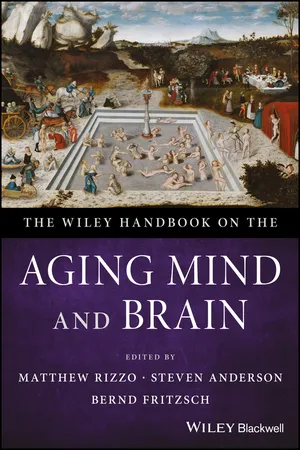
The Wiley Handbook on the Aging Mind and Brain
- English
- ePUB (mobile friendly)
- Available on iOS & Android
The Wiley Handbook on the Aging Mind and Brain
About This Book
A thought-provoking treatise on understanding and treating the aging mind and brain
This handbook recognizes the critical issues surrounding mind and brain health by tackling overarching and pragmatic needs so as to better understand these multifaceted issues. This includes summarizing and synthesizing critical evidence, approaches, and strategies from multidisciplinary research—all of which have advanced our understanding of the neural substrates of attention, perception, memory, language, decision-making, motor behavior, social cognition, emotion, and other mental functions.
Written by a plethora of health experts from around the world, The Wiley Handbook on the Aging Mind and Brain offers in-depth contributions in 7 sections: Introduction; Methods of Assessment; Brain Functions and Behavior across the Lifespan; Cognition, Behavior and Disease; Optimizing Brain Function in Health and Disease; Forensics, Competence, Legal, Ethics and Policy Issues; and Conclusion and New Directions.
- Geared toward improving the recognition, diagnosis, and treatment of many brain-based disorders that occur in older adults and that cause disability and death
- Seeks to advance the care of patients who have perceptual, cognitive, language, memory, emotional, and many other behavioral symptoms associated with these disorders
- Addresses principles and practice relevant to challenges posed by the US National Academy of Sciences and National Institute of Aging (NIA)
- Presents materials at a scientific level that is appropriate for a wide variety of providers
The Wiley Handbook on the Aging Mind and Brain is an important text for neurologists, psychiatrists, psychologists, physiatrists, geriatricians, nurses, pharmacists, social workers, and other primary caregivers who care for patients in routine and specialty practices as well as students, interns, residents, and fellows.
Frequently asked questions
Information
Part I
Introduction
1
The Aging Mind and Brain: Overview
Introduction
Goals of this Handbook
- Build the scientific basis for promoting neural health in the aging brain.
- Improve the understanding of the structure and function of the aging mind, including behavioral and neural mechanisms, and their impact on diseases and their management.
- Evaluate current methods of assessment of higher brain function and behavior and related factors across the lifespan.
- Determine how behavioral, social, cultural, and technological context affect cognitive functioning and real‐world performance of aging individuals and how to intervene effectively to augment individual functioning and performance in context.
- Address legal and policy implications for promoting safety and care of persons with cognitive challenges
- Analyze practice and policy issues that impact advancing science, models of care, treatment, outreach, access to care, and quality of life.
Overview of Contents
Part II. Theoretical, animal models, social, and humanistic perspectives
Table of contents
- Cover
- Title Page
- Table of Contents
- List of Contributors
- Acknowledgments
- List of Abbreviations
- Glossary
- Part I: Introduction
- Part II: Theoretical, Animal Models, Social, and Humanistic Perspectives
- Part III: Methods of Assessment
- Part IV: Brain Functions and Behavior Across the Lifespan
- Part V: Brain Disease and Dysfunction
- Part VI: Optimizing Brain Function in Health and Disease
- Part VII: Legal and Ethical Issues
- Part VIII: Conclusion
- Index
- End User License Agreement